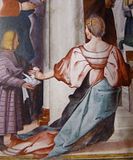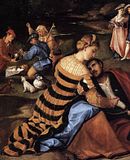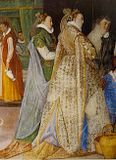LINING
OK, let's talk about lining in Italian 16th century dresses.
In "Moda a Firenze" it's described how tailors aimed to make the interlining and lining of the same colour as the outer fabric. This was probably to make it easier to clean/wash the garment.
At the same time, at least skirt linings in paintings often seem to be of a contrasting colour.
Do you think this was an artistic license to make the draping of the skirt more striking? Or was it just as common to use a contrasting fabric as lining? I know I've read that Eleonora di Toledo wore a black dress with golden/yellow lining and details in the triumphal visit to Rome in 1560.
Question is: I'm going to make a black dress in Roman style. Should I go for black lining or golden lining? Both appeals greatly to me, and both matching and contrasting lining seems to have been common. Anyone have any opinions on the matter?

White and dark brocaded dress with white bodice lining.

Doppia (possibly the whole lining) of similar colour as the outer fabric.

Red dress with what appears to be olive green lining.

Red dress with green lining and green trims.

Stripy golden/green (or black) dress with sky blue lining. Biggest contrast I've seen.

Lining appears to be the same colour as the outer fabric, but it's hard to tell because of the poor quality.

Red overdress with yellow/golden lining.

Pale brocaded overdress with blue lining.

Yellow dress with pale yellow lining.

Black overdress with black lining.